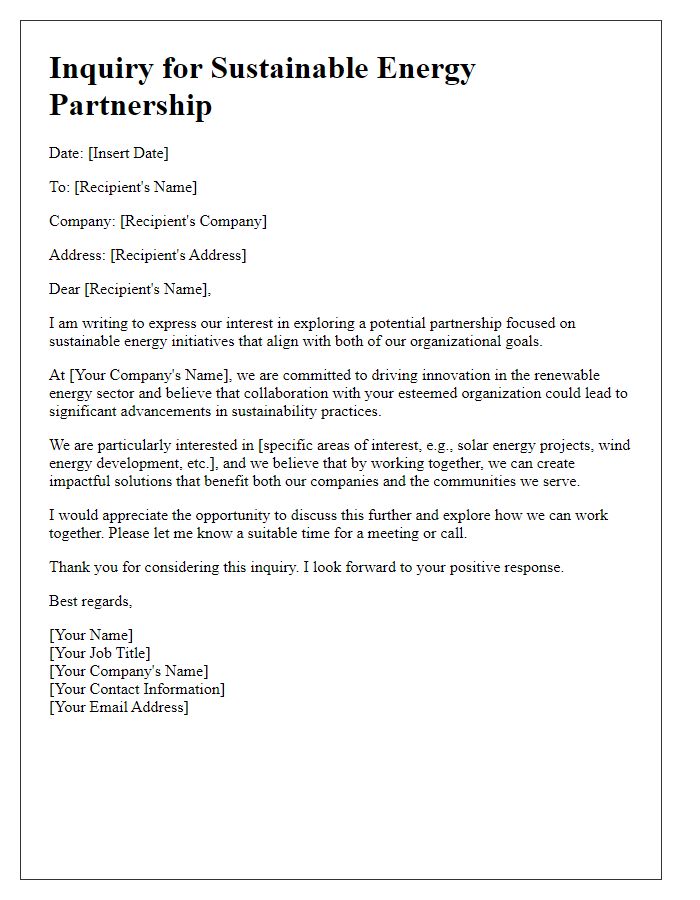Are you looking to make a positive impact on your community while also saving energy and lowering costs? Partnering in energy efficiency initiatives is a fantastic way to achieve both goals and create a sustainable future for everyone involved. We believe that joining forces with like-minded organizations can amplify our efforts and drive significant change. If you're interested in exploring partnership opportunities to enhance energy efficiency, keep reading to learn more!

Clear Purpose Statement
The energy efficiency partnership aims to reduce energy consumption across commercial buildings by implementing innovative solutions and technologies. This collaboration seeks to engage organizations throughout the corporate sector, especially those located in metropolitan areas known for high energy usage, such as New York City and Los Angeles. Through strategies like retrofitting outdated lighting systems with LED technology and optimizing HVAC (Heating, Ventilation, and Air Conditioning) operations, partners can collectively decrease energy bills by approximately 20-30% while simultaneously minimizing carbon footprint, an essential goal considering the increasing urgency of climate change as evidenced by the 2021 United Nations Climate Change Conference (COP26). This partnership not only focuses on tangible benefits but also fosters a culture of sustainability and environmental stewardship within participating organizations.
Mutual Benefits Highlight
Establishing an energy efficiency partnership can significantly enhance sustainability initiatives, yielding mutual benefits for both organizations involved. Collaborative projects aimed at reducing energy consumption can lead to substantial cost savings, with estimates suggesting a reduction of up to 30% in energy expenses over three years. Implementing shared resources such as energy audits (assessments of energy usage) or joint training programs for staff can promote knowledge transfer and innovation. Both partners can also achieve greater visibility in their respective industries, highlighting commitment to reducing carbon footprints (measured in tons of CO2 emissions) and contributing to local and national environmental goals. Additionally, partnerships can attract funding opportunities, as programs demonstrating collaborative energy efficiency efforts are often prioritized by governmental bodies, grants, and nonprofit organizations. Engaging in this type of partnership not only fosters goodwill but also amplifies the impact on community sustainability efforts.
Specific Energy Goals
A partnership request focusing on energy efficiency targets emphasizes collaboration between organizations to achieve significant sustainability outcomes. Specific energy goals, such as reducing energy consumption by 20% within three years, can promote investment in renewables, energy-efficient technologies, and best practices. For instance, implementing LED lighting can reduce electricity usage by up to 75%, contributing substantially to overall energy savings. Additionally, tracking metrics, such as kilowatt-hours saved or carbon dioxide emissions decreased, can provide quantifiable results. Engaging in this partnership in a city like San Francisco, known for its progressive environmental policies, can not only enhance corporate responsibility but also improve community relations and corporate image.
Call to Action
The transition to energy-efficient practices is essential for sustainable growth in sectors like manufacturing, commercial real estate, and residential communities. Renewable energy sources, such as solar and wind, can significantly reduce carbon footprints and lower operational costs, with potential savings of up to 30% on energy bills. Collaborations with organizations like the Energy Efficiency Program of the U.S. Department of Energy can provide resources and incentives for adopting energy-efficient technologies, such as LED lighting and high-efficiency HVAC systems. Initiatives like the ENERGY STAR certification can also enhance building marketability while contributing to environmental impact reduction. Together, we can drive change and promote a greener future.
Contact Information
An energy efficiency partnership request might involve organizations and companies committed to sustainable practices, seeking to collaborate on energy conservation initiatives. In this context, key players may include energy utility providers, environmental organizations, and local government agencies focused on reducing carbon footprints. Contact information can include important details such as the organization's name, physical address (often including the city, state, and ZIP code), phone number (possibly including a direct line for specific departments), and email address for direct communication. Furthermore, affiliation details with national programs like ENERGY STAR or local audit programs can enhance credibility and demonstrate commitment to energy-saving goals, fostering collaboration potential. Specific names of contact persons might also be significant for personalized outreach and establishing trust among future partners.













Comments